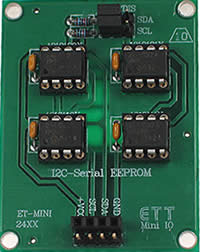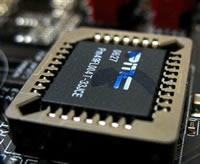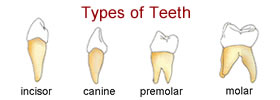Difference between EEPROM and FlashROM
Key Difference: EEPROM is a type of non-volatile memory that is a user-modifiable memory that can be constantly erased and re-programmed by users through applying higher than normal electrical voltage generated externally or internally. FlashROM is a universal flash programming utility used to detect, read, verify, erase, or write BIOS chips in DIP, PLCC, SOIC, TSOP, or BGA packages.
Since the beginning of computers there have been problems with memory and the ability to store data up until the computer is powered off or in cases to continue holding data even after it is powered off. The memory chips that were initially invented were expensive and could only be written on once before having to be discarded. This became a costly measure and those chips were only used to store programs that were required by the computer; however as the demand for cheaper memory grew, different types of memories were developed.
Let’s first understand what ROM is. Read-Only Memory is a type of non-volatile storage system in a PC. Every computer comes fitted with this memory that holds instructions for starting up the computer. ROM stores critical programs, such as the program that boots the computer and performs diagnostics. Data stored in ROM cannot be easily rewritten or modified. This data is also not lost when the computer is powered down.
 EEPROM, shorthand for Electrically Erasable Programmable Read-Only Memory, is a type of non-volatile memory that is used in computers and electronic devices to store small amounts of data and instructions that are required to power certain programs, even after the computer has been powered down, i.e. data such as calibration tables or device configuration. EEPROM is also known as E2PROM, double-e prom, e-squared and e-prom and it is a successor of EPROM (Erasable Programmable Read-Only Memory). EEPROM is a user-modifiable memory that can be constantly erased and re-programmed by users through applying higher than normal electrical voltage generated externally or internally. The original EPROM had to be removed from the system for erasing the memory and programming, while EEPROM do not required to be removed for erasing and programming.
EEPROM, shorthand for Electrically Erasable Programmable Read-Only Memory, is a type of non-volatile memory that is used in computers and electronic devices to store small amounts of data and instructions that are required to power certain programs, even after the computer has been powered down, i.e. data such as calibration tables or device configuration. EEPROM is also known as E2PROM, double-e prom, e-squared and e-prom and it is a successor of EPROM (Erasable Programmable Read-Only Memory). EEPROM is a user-modifiable memory that can be constantly erased and re-programmed by users through applying higher than normal electrical voltage generated externally or internally. The original EPROM had to be removed from the system for erasing the memory and programming, while EEPROM do not required to be removed for erasing and programming.
The dominant feature of EEPROM is that data can be entered and erased into the system one byte at a time, which allows the programmer to have full control of what data is being inputted. However, this method takes a long time as each data is inputted and erases byte by byte. EEPROM system can also be updated via patches and are usually used to hold the BIOS (Basic Input Output System) of the computer. Modern EEPROMs have abandoned the one-byte feature and have shifted to using multi-byte page operations; however they still have a limited life (the number of times the ROM can be reprogrammed). The EEPROM technology was built by George Perlegos in 1978 at Intel for the Intel 2816.
 FlashROM is a type of EEPROM; however it is not called an EEPROM and is considered as a separate type of memory. Wikipedia defines FlashROM as “a universal flash programming utility used to detect, read, verify, erase, or write BIOS chips in DIP, PLCC, SOIC, TSOP, or BGA packages.” It is commonly used to flash firmware images (i.e. BIOS or coreboot) to an existing firmware for back up. It is free software and is available under the GNU General Public License version 2. FlashROM is run from user space and usually requires superuser privileges. It has the ability to support over 300 flash chips, 220 chipsets, 401 mainboards, 50 PCI devices, 12 USB devices and various parallel/serial port and USB based device. It can also support cross-flashing and hot-flashing.
FlashROM is a type of EEPROM; however it is not called an EEPROM and is considered as a separate type of memory. Wikipedia defines FlashROM as “a universal flash programming utility used to detect, read, verify, erase, or write BIOS chips in DIP, PLCC, SOIC, TSOP, or BGA packages.” It is commonly used to flash firmware images (i.e. BIOS or coreboot) to an existing firmware for back up. It is free software and is available under the GNU General Public License version 2. FlashROM is run from user space and usually requires superuser privileges. It has the ability to support over 300 flash chips, 220 chipsets, 401 mainboards, 50 PCI devices, 12 USB devices and various parallel/serial port and USB based device. It can also support cross-flashing and hot-flashing.
FlashROM uses the Flash memory, which is a non-volatile memory that is used in computers to store data. It can be easily erased and programmed electrically. There are two types of Flash memory: NAND and NOR. These were named after the NAND and NOR gates as the individual flash memory cells exhibit similar characteristics to these gates. NAND type flash memory allows the memory to be divided into blocks, where memory is written and erased in blocks or pages and is usually smaller than the entire device, making it faster to write and erase data on the memory. NOR type memory allows a single machine word to be written and read independently. Due to the memory blocks working as one block for erasing, while still allowing data to be written at the byte level, flash has a significant advantage over the EEPROM. Flash is also considered to better as it consumes less power, is more durable and can survive excessive heat and pressure.
Both the EEPROM and Flash are both utilized in computer depending upon the company that is designing the system. Though, Flash is a type of EEPROM, it is considerably different in terms of writing and erasing data from the memory.
Image Courtesy: futurlec.com, apcmag.com









Add new comment